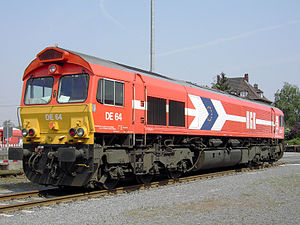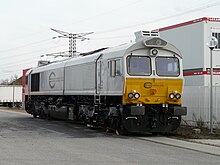EMD JT42CWR
| EMD JT42CWR (M) | |
|---|---|
|
HGK DE 64 in the Godorf harbor
|
|
| Number: | 464, 38 * |
| Manufacturer: | EMD |
| Year of construction (s): | 1998-2016 |
| Axis formula : | Co'Co ' |
| Gauge : | 1435 mm ( standard gauge ) |
| Length over buffers: | 21,349 mm |
| Height: | 3,912 mm |
| Width: | 2,692 mm |
| Bogie axle base: | 4,195 mm |
| Total wheelbase: | 17,424 mm |
| Smallest bef. Radius: | 80 m |
| Service mass: | 126 t, 129.6 t * |
| Wheel set mass : | 21.6 t |
| Top speed: | 120 km / h; 105 km / h ** |
| Installed capacity: | 2,350 kW 2,420 kW |
| Hourly output : | 2,268 kW |
| Starting tractive effort: | 409 kN; 467 kN ** |
| Driving wheel diameter: | 1,120 mm |
| Motor type: | 12N-710G3B-EC 12N-710G3B-T2 * |
| Motor type: | 12 cyl. V, two-stroke, turbocharged |
| Rated speed: | 900 rpm |
| Power transmission: | electric |
| Tank capacity: | 6550 l, 5150 l * |
| Number of traction motors: | 6 × D43TRC |
| Drive: | diesel-electric |
| Brake: | Air brake |
| Control: | EM 2000 |
| * JT42CWRM; ** Class 66/6 | |
The EMD JT42CWR and JT42CWRM are a type of electric powered diesel locomotive manufactured by Electro-Motive Diesel (EMD) .
The locomotive was developed in the 1990s by EMD, then a subsidiary of General Motors as the Electro-Motive Division , on behalf of the British railway company EWS as a successor to the EMD JT26CW-SS (Class 59). It was initially built in Canada in a number of 250 copies and introduced under the British series number 66 ( Class 66 ). The name "EMD Series 66" came about when the manufacturer began to market them in other countries. There are now 651 locomotives of this type in service across Europe. The last locomotive of this series delivered for the EU market was handed over to the railway company GB Railfreight on February 12, 2016 .
technology
The locomotive has a diesel engine with 2420 kW (3245 HP) and a mass of up to 129.6 tons distributed over six axles. The EM AR8 / CA6 three-phase generator feeds six series collector drive motors , which act on the axles with a dead- bearing drive .
The three-axle bogies have end axles that are radially steered in opposite directions, the central axle can be moved laterally.
The locomotives were developed for the British vehicle gauge, some of the locomotives delivered on the continent have additional attachments that make use in Great Britain impossible.
The locomotive has been offered in a revised version since 2005. For this variant called JT42CWRM (or also Class 77 or in Great Britain also 66/9 ) see below.
In Great Britain, a sub-series 66/6 is also in use, which is supplied with a modified gear ratio, which results in a higher tractive force of 467 kN at a lower top speed of 105 km / h.
Locomotives with modified gear ratios and increased tractive effort are operated in Germany by the Heavy Haul Power Int. operated and are marked as "High Tractive".
EMD has given up the development of a version 66EU for the continental European market. The series no longer fulfills the current EU emissions standard of Stage IIIA, which allowed orders to be placed until the end of 2014 during a transition period.
commitment
The JT42CWR (M) is used in heavy freight train service. It has no electrical heating device for the heating of passenger cars and also no preheating devices for the engine, so that the locomotives run through at low temperatures even when stationary, or have an automatic starter that starts the engine when the temperature of the operating materials (oil and cooling water temperature) starts automatically.
Class 66 is now used practically across Europe for freight trains, primarily by private railway companies such as RheinCargo in Germany. The locomotives are approved for operation in the United Kingdom, the Netherlands , Belgium , Luxembourg , Germany , Denmark , Sweden , Norway , Poland , France and Romania. Approvals in the Czech Republic and Slovakia were also sought.
The name Di 9 was originally intended for these locomotives at the Norwegian CargoNet . After delivery in January 2003, however, they were then classified as CD66 and have been in use since then from Trondheim on the Nordlandsbahn and to Støren in freight train service.
In 2007, the Egyptian State Railways (ENR) ordered forty Class 66 locomotives. They were delivered in 2009, have the road numbers 2124-2163 and are used in both passenger and freight traffic.
66001 of the Freightliner PL in Ruhland
Variant JT42CWRM
As of January 1, 2009, according to an EU directive on emissions standards, Class 66 could no longer be approved in the EU area . The fulfillment of the EU Stage IIIa exhaust gas standards that came into force in 2009 and the endeavor to reduce the very high noise level in the driver's cab through better sound insulation led to the development of a lower-emission variant called JT42CWRM. With an almost unchanged performance profile, additional installations resulted in an additional weight of almost 5000 kg, which was partially offset by a tank volume reduced by 1400 liters.
With this type, which includes the black Dispolok locomotives, some details of the locomotive were also changed on the outside. The most striking features are a third door on one side due to the partial elimination of a continuous side aisle in the locomotive body and a two-part driver's cab side window. The version with reduced noise and pollutant emissions also has larger fan shutters. The driver always sits on the left side of the locomotive.
The French subsidiary Euro Cargo Rail (ECR) of Deutsche Bahn AG owns 60 locomotives of this type and designates the locomotives as Class 77 , which are listed in the French register as 92 87 0077. Since October 2010, 31 of them have been used in Germany. They are in use at DB Cargo as class 266.4 (labeled as class 247.0) and are listed in the German vehicle register as 92 80 1266.
In Great Britain this variant is called Class 66/9 . In France, the vehicles were given the type designation 77,000. The series should not be confused with the Class 77 series from British Rail . The type designation 77 is also used differently in Belgium.
literature
- Helmut Petrowitsch: Class 66 - a fossil as a bestseller . In: railway magazine . No. 8/2007 . Düsseldorf 2007, p. 6-11, 35-37 .
- Helmut Petrowitsch: Diesel giants on six axles . In: railway magazine . No. 7/2013 . Alba publication, July 2013, ISSN 0342-1902 , p. 6-13 .
Web links
- Manufacturer's data sheet (PDF file; 658 kB)
Individual evidence
- ↑ http://class66.railfan.nl/ (above on Class 66 ).
- ↑ a b 'Last ever' Class 66 locomotives delivered (English, accessed on February 15, 2016)
- ^ Railway Gazette International, October 4, 2011: EMD to produce passenger demonstrator loco
- ↑ Heavyweights in freight transport . In: railway magazine . No. 8 , 2017, ISSN 0342-1902 , p. 86-86 .
- ↑ JT42CWRM Fact Sheet
- ↑ Electro-Motive Diesels (EMD) certifies its Class 66 (JT42CWRM) locomotive in Romania,
- ↑ without title . In: railway magazine . No. 7 , 2013, ISSN 0342-1902 , p. 8 .







